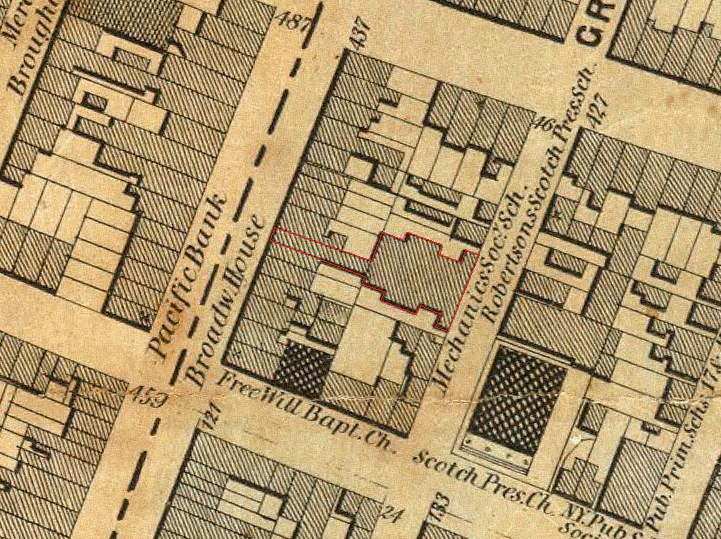Mechanics' Hall, New York City on:
[Wikipedia]
[Google]
[Amazon]
 Mechanics' Hall was a
Mechanics' Hall was a
Another Theatre Gone
''
 Mechanics' Hall was a
Mechanics' Hall was a meeting hall
In architecture, a hall is a relatively large space enclosed by a roof and walls. In the Iron Age and early Middle Ages in northern Europe, a mead hall was where a lord and his retainers ate and also slept. Later in the Middle Ages, the grea ...
and theatre seating 2,500 people located at 472 Broadway
Broadway may refer to:
Theatre
* Broadway Theatre (disambiguation)
* Broadway theatre, theatrical productions in professional theatres near Broadway, Manhattan, New York City, U.S.
** Broadway (Manhattan), the street
**Broadway Theatre (53rd Stree ...
in New York City
New York, often called New York City or NYC, is the List of United States cities by population, most populous city in the United States. With a 2020 population of 8,804,190 distributed over , New York City is also the L ...
, United States
The United States of America (U.S.A. or USA), commonly known as the United States (U.S. or US) or America, is a country primarily located in North America. It consists of 50 states, a federal district, five major unincorporated territorie ...
. It had a brown façade. Built by the Mechanics' Society for their monthly meetings in 1847, it was also used for banquet
A banquet (; ) is a formal large meal where a number of people consume food together. Banquets are traditionally held to enhance the prestige of a host, or reinforce social bonds among joint contributors. Modern examples of these purposes i ...
s, luncheon
Lunch is a meal eaten around the middle of the day. It is commonly the second meal of the day, after breakfast, and varies in size by culture and region.
Etymology
According to the ''Oxford English Dictionary'' (''OED''), the etymology ...
s, and speech
Speech is a human vocal communication using language. Each language uses Phonetics, phonetic combinations of vowel and consonant sounds that form the sound of its words (that is, all English words sound different from all French words, even if ...
es held by other groups.
The building eventually became a playhouse. During this time, it was variously known as the Abbey Theatre, Butler's American Theatre, and other names. The blackface
Blackface is a form of theatrical makeup used predominantly by non-Black people to portray a caricature of a Black person.
In the United States, the practice became common during the 19th century and contributed to the spread of racial stereo ...
minstrel
A minstrel was an entertainer, initially in medieval Europe. It originally described any type of entertainer such as a musician, juggler, acrobat, singer or fool; later, from the sixteenth century, it came to mean a specialist entertainer who ...
troupe Buckley's Serenaders
Buckley's Serenaders was a family troupe of English-born American blackface minstrels, established under that name in 1853 by James Buckley. They became one of the two most popular companies in the U.S. from the mid-1850s to the 1860s, the ot ...
saw great success there until 1846. Christy's Minstrels
Christy's Minstrels, sometimes referred to as the Christy Minstrels, were a blackface group formed by Edwin Pearce Christy, a well-known ballad singer, in 1843, in Buffalo, New York. They were instrumental in the solidification of the minstrel sh ...
became the resident minstrel company in February 1847, buying the building later in 1847. They remained until July 1854, when the troupe disbanded. Bryants Minstrels
Bryant's Minstrels was a blackface minstrel troupe that performed in the mid-19th century, primarily in New York City. The troupe was led by the O'Neill brothers from upstate New York, who took the stage name Bryant.Mahar 38.
History
The eldest ...
played at Mechanics' Hall for the first time in 1857, leaving after May, 1866, when the house was taken over for a season by minstrel showman Charles "Charlie" White
Charles T. "Charlie" or "Charley" White (1821–1891), was an early blackface minstrel entertainer.
Born June 4, 1821 in Newark, New York, White moved with his family at the age of two to New York City, where, before he launched his career as ...
.New York ''Clipper'', July 7, 1866.
In 1867, showman Robert Butler took over management of Mechanics' Hall following a fire that destroyed his former theater at 444 Broadway. Butler's luck was no better in the new venue as Mechanics' Hall was also destroyed by fire later that year.(8 April 1868)Another Theatre Gone
''
The New York Times
''The New York Times'' (''the Times'', ''NYT'', or the Gray Lady) is a daily newspaper based in New York City with a worldwide readership reported in 2020 to comprise a declining 840,000 paid print subscribers, and a growing 6 million paid ...
''
References
* Crawford, Richard (2001). ''America's Musical Life: A History''. New York: W. W. Norton & Company, Inc. * Henderson, Mary C. (2004). ''The City & The Theatre: The History of New York Playhouses: A 250 Year Journey from Bowling Green to Times Square''. New York: Back Stage Books. *Mahar, William J. (1999). ''Behind the Burnt Cork Mask: Early Blackface Minstrelsy and Antebellum American Popular Culture''. Chicago: University of Illinois Press. * Rock, Howard B. (1989). ''The New York City Artisan, 1789–1825: A Documentary History''. State University of New York. * Sweetster, M. F. (1883). ''New England: A Handbook for Travellers. A Guide to the Chief Cities and Popular Resorts of New England, and to Its Scenery and Historic Attractions: With the Western and Northern Borders, from New York to Quebec.'' 7 ed. Boston: James R. Osgood & Co.External links
* {{Broadway (Manhattan) Commercial buildings completed in 1847 1847 establishments in New York (state) Demolished buildings and structures in Manhattan Cultural history of New York City Former theatres in Manhattan Broadway (Manhattan) Buildings and structures demolished in 1868